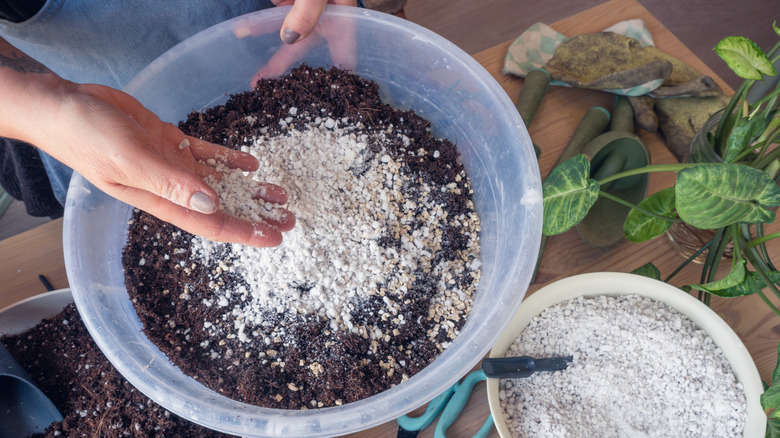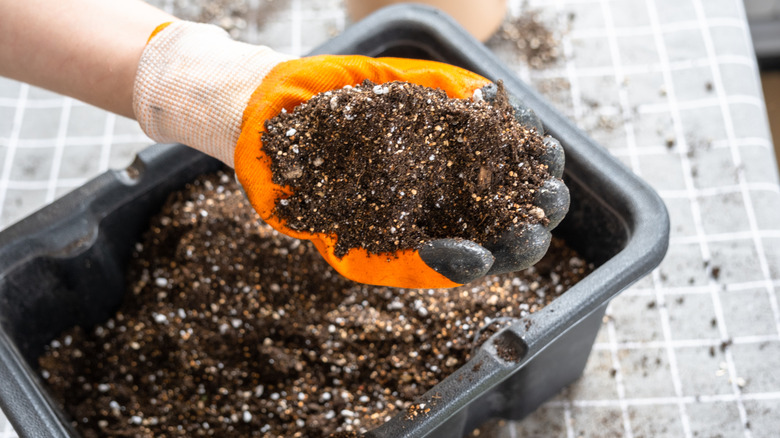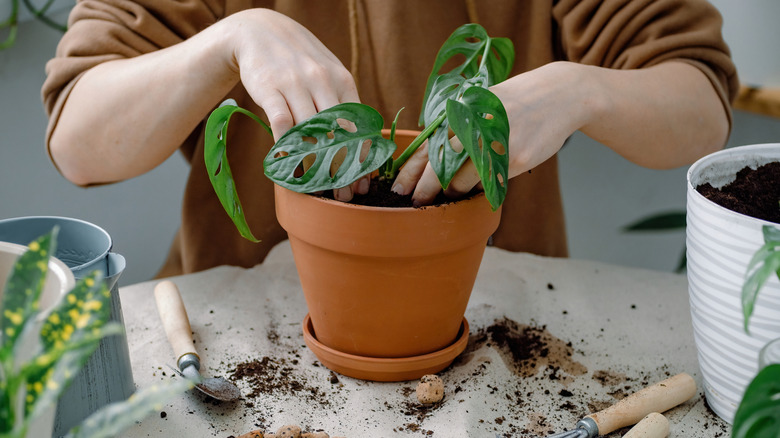The Best DIY Soil Mixes For The Most Popular Houseplants
We may receive a commission on purchases made from links.
If you're new to growing houseplants, you may have already realized that having the proper potting soil is important. And if you're already a houseplant aficionado, you know there are ready-made soil mixes created specifically for certain kinds of plants. These soil mixes can be a bit pricey, and not every plant nursery carries them, though they're often available via mail order. But with a bit of effort, you can make these soil mixes yourself by adding various amendments to store-bought potting soil. We've gathered up tips for making the best DIY unique homemade soil blends for three of the most common houseplants that have specific requirements: Monsteras, aloe, and spider plants.
Tiffany Selvey, House Digest's Garden Editor and in-house Master Gardener, explains, "Although the environmental conditions inside our homes may be pretty consistent, the soil needs for each type of houseplant we have may be very different. Since we bring everything from tropical plants that live deep in the rainforest to desert-natives into the same home, we need to consider each plant's native soil conditions to help our plants thrive."
Depending on what kind of plant you have, there are different functions you may need your soil planting mixes to fulfill. Most houseplants require good drainage. Some require additional nutrients. Certain indoor plants appreciate a sandy environment (like most succulents), while others like a more loamy soil to call home. Many plants perform best when their soil mix mimics their native environment, but others are not too fussy. Luckily, there's a range of products available to help you create the perfect mix.
Components of soil mixes
Using potting mix for indoor plants has many benefits, including improving soil texture and adding nutrients. When making your own potting mix, try to use the ingredients contained in the commercial preparations. Most commercial potting mixes used for container plants contain, in addition to soil, lightweight materials to aid drainage and airflow. Two common ingredients are vermiculite and perlite.
Perlite, a common garden soil amendment, comes in small white chunks that feel a bit like styrofoam, is a form of volcanic glass that is mined and then treated until it becomes porous. Perlite helps improve soil texture in gardens or containers, giving plants more access to oxygen, and improving drainage. It does not add any nutrients. Similar to perlite, vermiculite, a silvery soil amendment, is also mined and treated to help it become more absorbent. Vermiculite adds useful minerals to soil and absorbs moisture, making it helpful for plants that require good drainage. Vermiculite can also be used to store bulbs or rhizomes for overwintering (like cannas, dahlias, or gladioli) to keep them dry and prevent damp rot.
Other ingredients used in commercial potting mixes, depending on their purpose, may include sand, peat moss, compost, coco coir (shredded coconut shells), worm castings (worm poop), rice hulls, or shredded pine bark (which improves acidity and texture). You can buy bags of perlite, vermiculite, mushroom compost, sand, and peat moss at most garden centers. You can also try nurseries specializing in houseplants, or you can order online for home delivery.
Best soil mixes for monstera, aloe, and spider plants
Here are three popular houseplants and the best DIY soil mixes to suit their needs. Monstera deliciosa (also called Swiss cheese plant) is a tropical plant that likes moist but well-draining, slightly acidic potting soil, with amendments to help aerate the soil and improve drainage. A specialized mix, like Gardenera's Premium Monstera Potting Soil, works well, containing New Zealand bark, peat moss, coco coir, and perlite. To make your own, mix together three parts peat-based houseplant soil (like FoxFarm's Organic All Purpose Potting Soil), two parts shredded pine bark (this improves acidity), and one part perlite to create a suitable potting mix for your monstera.
What about your aloe vera (Aloe barbadensis miller)? This succulent is native to desert environments. However, some succulent soil mixes contain extraneous ingredients, like fertilizers. Miracle-Gro's succulent potting mix contains sphagnum peat moss, forest products, and Miracle-Gro plant food. However, aloe vera doesn't really need extra fertilizer or nutrients and is often found growing in nutrient-poor sandy desert soil. A DIY mix of three parts all-purpose potting soil, one part perlite or vermiculite, and one part coarse sand is perfect for your aloe vera.
The humble yet beautiful spider plant (Chlorophytum comosum) is easy to grow. The spider plant needs good drainage and prefers loamy soil with a neutral pH. Because peat moss is slightly acidic, you can balance this acidity for a more neutral soil mix by adding coco coir, which is slightly more alkaline. Try a mix of three parts all-purpose potting soil, one part perlite, and one part coco coir to keep your spider plant healthy and happy.


